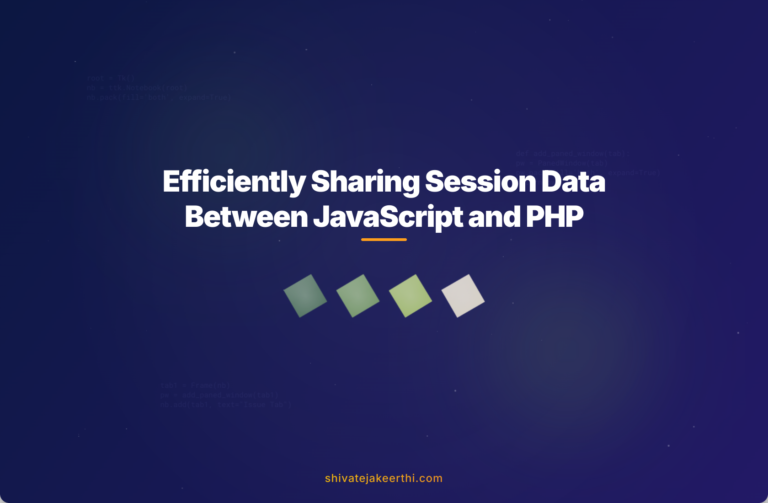Have you ever worked on a project where both JavaScript and PHP are involved and wondered how these two popular technologies can efficiently share session data? Session data helps developers store information across multiple page requests, enhancing user experience by maintaining state. Many web applications today rely on this functionality for everything from shopping carts to login management. Let’s explore easy, practical ways to share session data seamlessly between JavaScript and PHP effectively.
Understanding Sessions in PHP
PHP sessions help websites recognize users individually, storing temporary data without depending on cookies or databases directly. When a user visits your site, PHP assigns a unique session ID, allowing you to keep track of data related to this particular user throughout their visit.
To start a session and store data in PHP, you use the built-in session_start() function at the top of your page:
<?php
session_start();
$_SESSION['username'] = "john_doe";
$_SESSION['email'] = "john@example.com";
?>Once set, these variables will be available across multiple pages in your application until the user closes their browser or you explicitly destroy the session.
JavaScript Session Storage Explained
JavaScript provides built-in browser storage methods like sessionStorage and localStorage. Though somewhat similar to PHP’s sessions—storing data temporarily—these are handled client-side within the user’s browser and aren’t directly communicated back to your PHP scripts.
sessionStorage allows you to store data until the browser tab is closed, while localStorage persists data even after the browser is closed and reopened. Here’s how you use sessionStorage:
// Store data in JavaScript sessionStorage
sessionStorage.setItem('productID', '12345');
// Retrieve data from sessionStorage
let id = sessionStorage.getItem('productID');
console.log(id); // Outputs: 12345
Sharing Data from JavaScript to PHP
Since JavaScript runs client-side and PHP runs on the server, passing session data back requires explicit communication. A popular way to do this is using AJAX.
AJAX enables JavaScript to send data asynchronously to a PHP script without refreshing the web page. With libraries like jQuery or native fetch calls, implementing AJAX is straightforward. Here’s a basic example using JavaScript’s fetch API:
// JavaScript sending sessionStorage data to PHP using fetch()
let userId = sessionStorage.getItem('userId');
fetch('updateSession.php', {
method: 'POST',
headers: {
'Content-Type': 'application/x-www-form-urlencoded'
},
body: 'userId=' + encodeURIComponent(userId)
})
.then(response => response.text())
.then(result => console.log(result));
On the PHP side (`updateSession.php`), you capture that data easily:
<?php
session_start();
if($_SERVER['REQUEST_METHOD'] == "POST" && isset($_POST['userId'])){
$_SESSION['userID'] = $_POST['userId'];
echo "Session updated!";
}
?>Sharing Data from PHP to JavaScript
Sometimes, you’ll need to pass session data from PHP to JavaScript—to render personalized UI elements, track specific behaviors, or trigger certain events based on user data.
The simplest and most secure approach is to output session variable data within your JavaScript directly by JSON encoding:
<script>
let sessionData = <?php echo json_encode($_SESSION); ?>;
console.log(sessionData.username); // outputs username stored in session
</script>
Using PHP’s built-in json_encode() ensures data is safe and correctly formatted for JavaScript.
Bidirectional Data Sharing Between PHP and JavaScript
Effective bidirectional sharing often involves AJAX interactions that send and read JSON-formatted data. Here’s a streamlined example:
JavaScript initiates data transfer with AJAX:
// example JavaScript snippet sending data to PHP and receiving response
fetch('processUserData.php', {
method: 'POST',
headers: {
'Content-Type': 'application/json'
},
body: JSON.stringify({ action: 'getUserData' })
})
.then(response => response.json())
.then(session => {
sessionStorage.setItem('username', session.username);
console.log('Session updated in JS:', session.username);
});
Corresponding PHP script (`processUserData.php`):
<?php
session_start();
header('Content-Type: application/json');
$data = json_decode(file_get_contents('php://input'), true);
if(isset($data['action']) && $data['action'] == 'getUserData' && isset($_SESSION['username'])){
echo json_encode(['username' => $_SESSION['username']]);
}
?>
With this method, JavaScript and PHP can freely exchange session-related data, improving interaction and enhancing user experiences.
Security Considerations When Sharing Data
Sharing data between server-side and client-side carries some risk, especially when data is sensitive, such as user credentials or payment details.
To secure data sharing, always:
- Validate and sanitize input data using methods like PHP’s filter_input().
- Avoid directly outputting sensitive session data into JavaScript. Keep sensitive session variables securely server-side.
- Consider using HTTPS connections to encrypt all data exchanges and minimize risks of attacks like man-in-the-middle attacks.
- Use secure & HttpOnly flags when setting essential cookies via PHP’s
setcookie().
Real-World Applications of Session Data Sharing
Consider the common e-commerce shopping cart scenario: a user selects items using JavaScript interactions on your website, which are then sent to PHP to store reliably.
Alternatively, think of personalized experiences like user dashboards or account pages. PHP holds sensitive user data securely while JavaScript uses SELECTIVE session data to dynamically modernize your user interface for richer interactivity.
Sharing session data efficiently enables better integration of frontend and backend systems, improving workflow and ultimately enhancing user satisfaction.
Imagine an online quiz application: PHP tracks correct answers, generates quizzes, and securely stores user progress—while JavaScript offers interactive feedback, animations, and better user engagement. Such integration demonstrates the importance of seamlessly connecting JavaScript and PHP via session data sharing.
These practices empower your web development skills—creating intuitive, interactive, and secure applications.
Whether you’re building an e-commerce site, developing online quizzes, or implementing customized dashboards—having your PHP and JavaScript communicate effectively is essential. By mastering PHP and JavaScript session handling, you’re better equipped for dynamic web excellence.
How do you implement session sharing between JavaScript and PHP in your projects? Share your experiences and tips below!



0 Comments